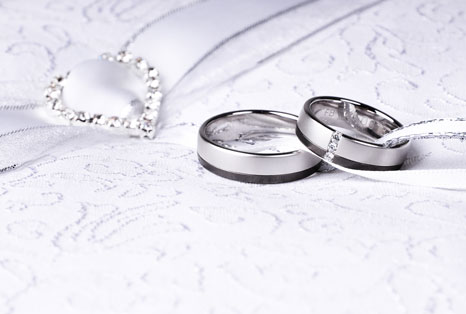Learn About Precious Metals
Precious Metals: A Jewelry Care, Cleaning and Purchasing Guide

Precious metals have played an integral role in jewelry, the arts, currencies and trade since before the beginning of recorded history. Precious metal jewelry has maintained a significant symbolic value, in addition to high economic value, for thousands of years.
Distinctive in use and interpretation to each culture and society, precious metals in jewelry are representative of a wide array of symbolic significance. Rings, pendants and coins made from precious metals have been worn as jewelry, symbolizing life-long promises, social status and wealth.
Cleaning, Storage and Jewelry Care
It is the rare metallic and transitional components of precious metals which make it possible for jewelers to create the transcendent treasures of the jewelry seen today. New discoveries in industrial, alternative and noble metals fuel a constantly evolving world of jewelry design.
Through proper cleaning, care and elemental exposure, precious metal jewelry can be preserved for future generations to enjoy.
The most widely recognized precious metals are Gold (Au) and Silver (Ag). The platinum group of precious metals (PGMs) includes Palladium (Pd), Platinum (Pt), Rhodium (Rh) and Iridium (Ir).
Gold (Au)
An indestructible material, gold, in its pure form, is not only impervious to tarnishing, but also has the unique ability to be simultaneously dense, soft, shiny, and malleable. Gold is the most malleable and ductile of all metals.
To create various colors in gold metal jewelry, it is alloyed with other metals to yield the desired result. For example, ‘white gold’ is an alloy of gold and nickel.
The purity of gold is expressed in karats (kt), on a scale of 24, or in fineness, on a scale of 1,000. Pure gold is 24 karat, or 1,000 fine. Using this standard we know that 18 karat gold is an alloy containing 75 percent gold.
Reference Guide to Gold in Karats
- 10k = 10/24 = 41.67% pure gold
- 14k = 14/24 = 58.33% pure gold
- 18k = 18/24 = 75.00% pure gold
Gold is the most highly regarded of the precious metals. With a distinct yellow color, gold also has the unique and impressive ability to maintain its luster. This precious metal is also resistant to oxidation in the air, water, or by solid chemical elements.
Gold Jewelry Cleaning and Care
- Gold responds well to a simple buffering with a soft cloth, giving gold a renewed shine easily.
- Most gold jewelry is completely safe to clean in a warm soapy water solution, and able to be intricately cleaned with the bristles of a toothbrush without any visible harm.
- Many experts advise avoiding contact with household chemicals to avoid tarnishing gold jewelry.
- Bleach will definitely damage lower karat gold purities, and should be avoided completely in the care of any precious metal.
To create various colors in gold metal jewelry, it is alloyed with other metals to yield the desired result. For example, ‘white gold’ is an alloy of gold and nickel.
The purity of gold is expressed in karats (kt), on a scale of 24, or in fineness, on a scale of 1,000. Pure gold is 24 karat, or 1,000 fine. Using this standard we know that 18 karat gold is an alloy containing 75 percent gold.
Silver (Ag)
Silver has the highest electrical and thermal conductivity of all metals. The brilliant white metallic luster of pure silver is one of the many reasons it is commonly used in jewelry. More affordable than gold, with strong ductile and malleable properties, silver is a popular choice in precious metal jewelry.
While silver remains stable in pure air and water, it does possess the lowest resistance to contact with various other elements. Silver is easily susceptible to tarnishing when exposed to sulphur, hydrogen sulphide and various naturally occurring elements of the ozone.
Pure silver has the ability to maintain a vibrant luster for long periods of time when properly stored, cleaned and cared for. Silver jewelry is commonly used as a budget-friendly alternative to gold or platinum in diamond ring settings. The distinctive bright luster is a complementary metal to enhance the diamond of an engagement ring.
Silver Jewelry Cleaning and Care
- To maintain the brilliant luster distinctive to pure silver, avoid unnecessary exposure to moisture, peroxide and household solvents.
- The most effective approach to removing mild tarnishing and brighten up your silver is by buffing the metal with a soft, dry cloth.
- If silver jewelry is severely tarnished, it is recommended that the item be taken for a professional cleaning by a Preferred jeweler.
Platinum Group Metals (PGMs)
Platinum in jewelry is actually an alloyed group of six other metals. Referred to as the platinum group of precious metals (PGMs), these include Palladium (Pd), Platinum (Pt), Rhodium (Rh) and Iridium (Ir).
Platinum (Pt)
With its distinct whitish-gray color, platinum is vibrant, dense and malleable. Platinum is also one of the rarest elements found within the Earth’s crust.
Not only is platinum elegant in appearance, but it is also resistant to corrosion by air, water or oxidation. With the added benefit of hypo-allergenic elements, platinum is a favored choice for all types of jewelry.
Platinum is quickly becoming the pre-eminent metal for fine jewelry, having seen a rapid growth in popularity over the recent years. It is a metal more rare, and as a result, more expensive than even gold.
Platinum is the strongest precious metal found in jewelry. Commonly used in bridal and engagement ring settings, platinum is often attributed to bringing out the brilliance of diamonds through its unique shimmery luster.
Platinum Jewelry Cleaning and Care
- While platinum is extremely dense and strong, this precious metal is susceptible to scratching. It is recommended that you store platinum jewelry separately, in a velvet pouch if possible.
- Avoid the use of heavy cleaning solutions and be sure to remove platinum jewelry prior to manual labor.
- With platinum jewelry, an occasional professional cleaning by a Preferred jeweler, an expert in the handling of platinum, is strongly recommended.
Palladium (Pd)
Palladium resembles the vibrant coloring of silvery-grayed platinum. However, there are strong differences between the two chemically.
Palladium exhibits strong ductile and malleable qualities, yet it is the least dense and has the lowest melting point of all the precious metals. Palladium is among the top three most commonly used metals in manufacturing white gold alloys.
Rhodium (Rh)
Rhodium is one of the rarest of precious metals. It is also among the most expensive. Considered a noble metal, Rhodium is resistant to corrosion, which is in large part the reason it is utilized as an alloy in platinum jewelry.



